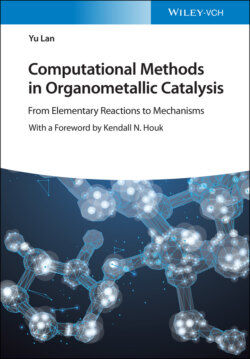Читать книгу Computational Methods in Organometallic Catalysis - Yu Lan - Страница 29
2.3 Basis Set and Its Application in Mechanism Studies 2.3.1 General View of Basis Set
ОглавлениеIn quantum chemistry calculations, a common approach is to represent a molecular orbital as a LCAO
in which each atomic orbital is represented by a single mathematical function. The atomic orbitals used in this procedure are represented by what is known as the basis set. Following this idea, the mathematical form of atomic orbitals should be considered, when it is used to be linear combinations for the construction of molecular orbitals. One choice would be to simply use the hydrogenic wavefunctions adapted for other atoms, which is called a Slater-type orbital (STO). These wavefunctions have radial forms possessing terms such as rn−1e−ζr (ζ = Z/n), whose function form has clear physical meaning (Scheme 2.3a). However, it is very difficult to evaluate the complex two‐electron integrals.
Scheme 2.3 The combination of Gaussian‐type orbitals (GTOs) for the construction of Slater‐type orbital (STO). (a) STO. (b) GTO. (c) The combination of GTOs.
Following a suggestion of Boys, Pople decided to use a combination of Gaussian‐type functions to mimic the STO, which was named Gaussian‐type orbital (GTO). These orbitals have a different spatial function, X′Y‴Z′e−ζr2; therefore, the integrals required to build the Fock matrix can be evaluated exactly (Scheme 2.3b). The tradeoff is that GTOs do differ in shape from the STOs, particularly at the nucleus where the STO has a cusp, but the GTO is continually differentiable. The computational advantage is so substantial that it is more efficient to represent a single atomic orbital as a combination of several GTOs rather than a single STO (Scheme 2.3c). When a few GTOs with differing shapes are added, the result is a function that resembles an STO. Now, the basis set is not just the atomic orbitals, but is instead all the GTOs that are used to make up the atomic orbitals. The minimum Gaussian‐type basis set is STO‐3G, in which “STO” is the abbreviation of STO, and “3G” means that each STO is obtained by a linear combination of three GTOs [66, 67].
The minimum basis set has one basis function for every formally occupied or partially occupied orbital in the atom, which is referred to as a single‐zeta (SZ) basis set. The use of the term zeta here reflects that each basis function mimics a single STO, which is defined by its exponent, zeta (ζ). The minimum basis set is usually inadequate, failing to allow the core electrons to get close enough to the nucleus and the valence electrons to delocalize. An obvious solution is to double the size of the basis set, creating a double‐zeta (DZ) basis. Further improvement can be had by choosing a triple‐zeta (TZ) or even larger basis set [68].
